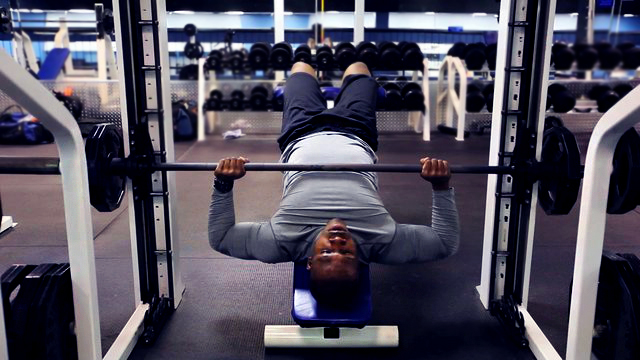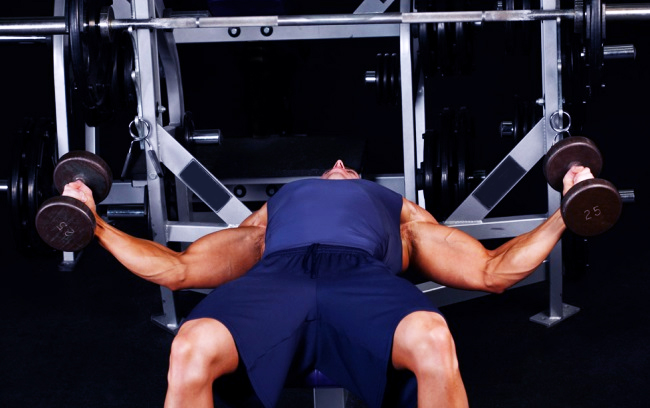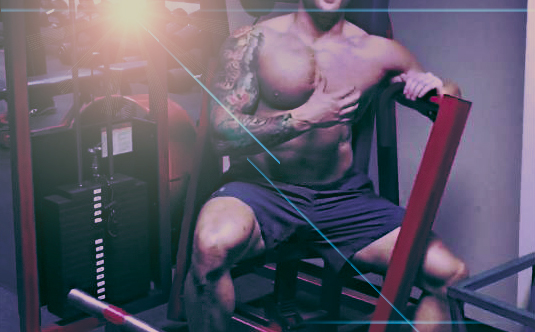This chest workout takes you through five exercises which target the different portion of the chest. Starting from a decline, targeting the lower pectoral; then moving through the different angles, from flat up to incline. This chest workout ensures that the entire pectoralis is stimulated using different weight loads to increase tears in the muscle fibres, which should help to maximise muscle growth.
Before you begin the workout, ensure that your shoulders are warmed up. Perform a few shoulder flys and warm up the rotator cuffs, as injuries can occur if they have not been sufficiently warmed.
Smith-Machine Decline Bench
The smith-machine decline bench will be your first routine. This will target more-so the lower portion of the pectorals. As it is your first workout routine, you should have almost full strength and energy levels, as a result, this routine will be the most effectual and you will likely see a high degree of development in the lower pectorals, compared to the impact of the other routines on the rest of the chest.

Set up the decline bench to about a 20-40 degree angle. Find what angle works for you. Some people do go as steep as 45 degrees, but whatever angle you opt for, ensure that it places the most tension on the lower pectoral.
Next, you need to make sure that the bar is aligned in the right position for your body. Make sure that no weight is on the bar then test the alignment by performing a few reps. The bar should fall on the eccentric (lowering) phase to about your lower pectorals. If it falls further up your chest your shoulders will end up taking more tension than they should – avoid this.
Once set up, place a light-weight on the bar and perform a warm-up set, going through a full range of motion.
Now you are going to perform four working set using a pyramid training structure.
Each set will get progressively heavier apart from the last set, which you will perform a sort of reverse pyramid, by dropping down on the weight load and increasing the rep range.
Set 1 to 2 while getting progressively heavier should be kept to a 10 rep range per set.
Set 3 should be your heaviest set with a rep range of 6-8 going to failure.
Set 4 you will pyramid down to a lighter weight roughly at the weight of set 1 or slightly less. Your aim with set 4 is for a slow controlled contraction throughout the movement, with a slightly increased time-under-tension. Your rep range should be 12-15. This set is about maximising tension and forcing as much blood into the pectorals as you can. When performing the movement, with a firm grip on the bar, try to push your hands closer together to focus maximal tension on the chest. You will feel this especially on the eccentric phase of the contraction.
Set 1: 10 reps
Set 2: 10 reps (increase the resistance)
Set 3: 6-8 reps (increase the resistance)
Set 4: 12-15 reps (decrease the resistance)
Flat Dumbbell Bench Press
The second routine, flat dumbbell bench press will see a significant reduction in the maximal weight load lifted. Obviously, your pectorals at this point have gone through a vigorous workout routine beforehand, hence a reduction in the maximum weight load, due to muscle fatigue.
Perform three sets of the same weight load for 10 reps going to failure, each. Ensure proper form is maintained throughout the movement. Do not lock out your arms on the concentric (raising) phase.
Allow for 1 minute 30 seconds between each set to ensure that you can perform 10 reps per set.
Once all three sets are complete, drop the weight by 20% or slightly more, so that you can accomplish a 12-15 rep set, under a slow controlled tempo. This will be your fourth and final set. The reasoning behind dropping the weight load on this set is to increase stress on the pectorals, through perfect execution of technique and an increased in time-under-tension.
Set 1: 10 reps
Set 2: 10 reps (maintain the same resistance)
Set 3: 10 reps (maintain the same resistance)
Set 4: 10-15 reps (decrease the resistance)
Flat Bench Dumbbell Flys
Similar to the flat dumbbell bench press, in that, the routine consists of three straight sets of ten reps each, with the additional fourth set being a reduced weight load and an increased rep range.

The first three sets should be taken to failure or almost failure – within one rep. Maintain form throughout the movement with a slight bend at the elbows on the eccentric (lowering) phase. On the concentric (raising) phase, you want to straighten your arms at the elbow joint and to maintain a slight angle at the peak of the contraction – do not bring your arms all the way up. You do not want both dumbbells to touch one another, as at this position the tension applied to your pectorals will diminish.
Your rest time between sets should be about 1 minute.
Your final set, the fourth, should see a significant reduction in weight load – about 25-30 per cent. The focus on this set is to increase the range of motion of the movement performed. While it’s key to have a full pectoral stretch on the eccentric, you still want to be safe doing so. Active stretching should be included in your training regime at some point so that the range of motion can be increased safely.
With your final set, try to get a deeper descent at the eccentric phase of the exercise. Try to stretch out your pectorals as much as you find is comfortable. Keep the eccentric phase slow and controlled. Again, when you bring the weights back up, do not go vertical, allow for about 10-degrees from vertical so that tension remains on the target muscle. When you get to the peak of the contraction, straighten your arms at the elbows and squeeze your pectorals as hard as you can.
1 set 10-15 reps
Set 1: 10 reps
Set 2: 10 reps (maintain the same resistance)
Set 3: 10 reps (maintain the same resistance)
Set 4: 10-15 reps (decrease the resistance)
Incline Dumbbell Bench Press
The fourth routine, incline dumbbell bench press, will target the upper fibres of the pectorals (clavicular portion of the pectoralis major). There will also be some recruitment of the deltoids and the triceps. Following a similar format to the flat dumbbell bench press, you are going to perform three straight sets for 10 reps going to failure each time. Then on your fourth and final set, you will drop the weight load by at least 20% for 10-15 reps.
Setting up the bench to the correct incline is crucial. If the angle is too steep you risk putting too much tension away from the upper pectorals and more on to the frontal deltoids. You should adjust the back cushion angle to about a 20-degree inclination – this should maximise recruitment of the upper pectoral fibres.
For the first three sets, you want a weight that you can perform 10 reps going to failure. Maintain good form throughout the entire exercise – planting your feet firmly into their floor, keeping your lower back flat against the bench, contacting your abs, and ensuring that the shoulders blades are pinned back. Bring the dumbbell into a pre-lift position onto your legs. When you sit back and lift the dumbbells into the benching position, make sure to first raise both dumbbells above your head with arms locked. Pause for a second or two so that you are prepared, adjusting arm position if needed and to stabilise your arms and shoulders.
Once ready, bring the dumbbells down in a controlled descent, in alignment with the upper chest – just below the chin – so that there is a stretch on the upper chest. Pause briefly so that the weight doesn’t bounce, then press the dumbbells back up to the top but do not lock out.
Allow for a 1-minute 30-second rest between each set. Once complete, drop the weight by 20 per cent or slightly more for your fourth set. This set will have a rep range of 10-15 reps and with a slower lifting tempo for an increased time under tension. Implement the same form as the previous set.
The fourth set will help in developing better control and execution of the exercise, due to the slower lifting tempo. Due to the lower resistance, you should have greater control in manipulating where the tension is transferred to around the chest. Furthermore, with the lighter resistance, you can squeeze and contract the target muscle with greater force as there is less recruitment of stabilising muscles. And this combined with the slightly higher rep range should give you the ability to pump more blood into the target muscles, inducing greater muscle fibre tears, leading to greater muscle hypertrophy.
Set 1: 10 reps
Set 2: 10 reps (maintain the same resistance)
Set 3: 10 reps (maintain the same resistance)
Set 4: 10-15 reps (decrease the resistance)
Cross Body Machine Chest Press
The cross body machine chest press is performed using reverse pyramid training sets. You will decrease the weight on each set, and as you do this you will increase the reps performed.

The cross body machine chest press will emphasise the internal pectorals in the same way that a cable crossover does. However, due to the pressing motion of the exercise, rather than a fly, you will be able to load up and control a much higher resistance. Though the pectoral will not receive a full stretch as it would under a fly movement, it does receive a more intense contraction at the peak of the movement, compared to the fly.
As this will be a reverse pyramid routine, you will have to assess first what weight loads you will be capable of lifting using the specified rep ranges. Best estimates are fine, but remember to stay safe, especially if it is a routine you have never performed before. Write down all lifts performed in a log book. That’s each set, the weight load lifted, and the number of reps performed per set. This will help when you next perform this workout to find suitable weight loads for each set.
Start by adjusting the seating so that your arm crosses your body parallel to the floor. No incline or decline. You should be seated with your body side on to the machine with the side of your back (latissimus dorsi) rested against the back cushion – your working arm should be free, over the edge of the backrest. Perform a few reps to ensure that the alignment is correct. Now load up the bar for set 1, this will be your heaviest set.
Once loaded, get back into position. Brace yourself with a straight back, tight core and a strong footing on the floor. Now, with your free hand, place your thumb onto the inner working pectoral – this will help you to judge the contraction. Grip the bar with the working hand and perform, if you can, 8-10 reps. Keep your thumb of your free hand in place throughout the movement to ensure that the inner pectoral is working. You should be pushing for maximal contraction on the concentric phase of the lift – that’s when your arm is fully extended. On the peak of the concentric, push and squeeze the inner pectoral as hard as you can against your thumb.
Repeat the routine with the opposite side of the chest. Give yourself about 30 seconds rest between sets.
Next, drop the weight and repeat using the modified rep range of 10 reps on both sides of the chest. Again, with a 30 second rest between sets.
Your third and final set, moving down through the pyramid, will be the lightest. Remove weight from the bar and perform the same actions as before, but this time with a 12-15 rep range. Stay with a 30-second rest between sets, but this time, push and hold at the peak of the contraction for 1-2 seconds, remembering to squeeze your working pectoral as hard as possible.
Set 1: 8-10 reps
Set 2: 10 reps (decrease the resistance)
Set 3: 12-15 reps (decrease the resistance)

